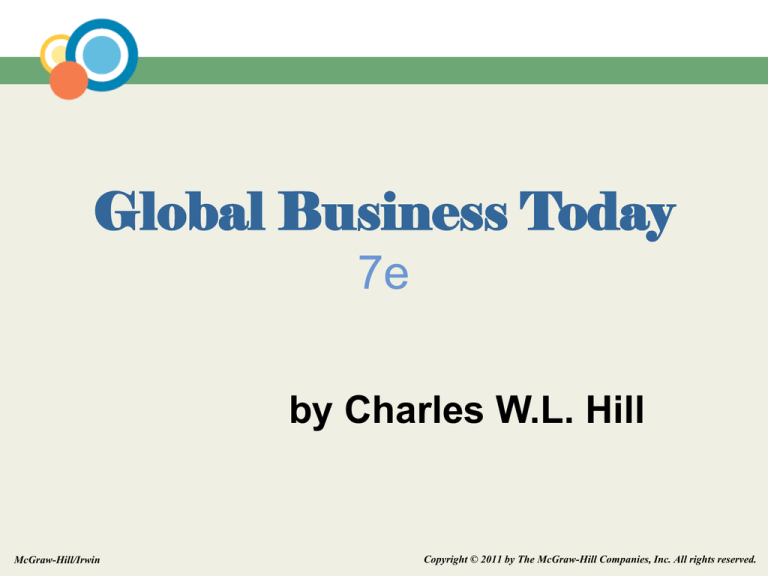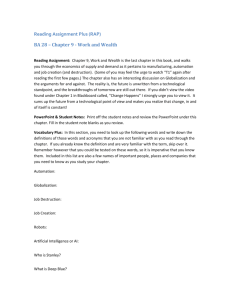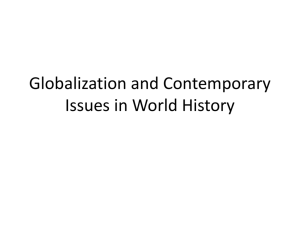
Global Business Today
7e
by Charles W.L. Hill
McGraw-Hill/Irwin
Copyright © 2011 by The McGraw-Hill Companies, Inc. All rights reserved.
Chapter 1
Globalization
1-2
Introduction
In the world economy today, we see
fewer self-contained national economies with high
barriers to cross-border trade and investment
a more integrated global economic system with lower
barriers to trade and investment
over $4 trillion in foreign exchange transactions daily
over $12 million of goods and $3.3 trillion of services
being sold across national borders
the establishment of international institutions
1-3
What Is Globalization?
Question: What is globalization?
Answer:
Globalization refers to the trend towards a more
integrated global economic system
Two key facets of globalization are:
the globalization of markets
the globalization of production
1-4
The Globalization of Markets
Globalization of markets - the merging of
historically distinct and separate national markets
into one huge global marketplace
In many markets today, the tastes and
preferences of consumers in different nations are
converging upon some global norm
Coca Cola, Starbucks, Sony PlayStation, and
McDonald’s hamburgers, IKEA furniture
1-5
The Globalization of Production
Globalization of production - the sourcing of
goods and services from locations around the
globe to take advantage of national differences in
the cost and quality of factors of production
(labor energy, land, and capital)
Goal: lower overall cost structure or improve the
quality or functionality of their product and gain
competitive advantage
Boeing and Vizio
1-6
The Emergence of Global Institutions
Global institutions
manage, regulate, and police the global market place
promote the establishment of multinational treaties to
govern the global business system
the World Trade Organization (WTO) - polices world
trading system and ensures nations adhere to the rules
established in WTO treaties
In 2010, its 154 members accounted for 97% of world
trade
the International Monetary Fund (IMF) - maintains order
in the international monetary system
1-7
The Emergence of Global Institutions
the World Bank - promotes economic development
the United Nations (UN) - maintains international peace
and security, develops friendly relations among nations,
cooperates in solving international problems and
promotes respect for human rights, and is a center for
harmonizing the actions of nations
1-8
Drivers of Globalization
Question: What is driving the move toward greater
globalization?
Answer:
1. declining trade and investment barriers
2. technological change
1-9
Declining Trade and Investment Barriers
International trade occurs when a firm exports goods or
services to consumers in another country
Foreign direct investment (FDI) occurs when a firm
invests resources in business activities outside its home
country
During the 1920s and 1930s, many nations erected
barriers to international trade and FDI to protect domestic
industries from foreign competition
1-10
Declining Trade and Investment Barriers
After WWII, advanced Western countries began
removing trade and investment barriers
Under GATT (the forerunner of the WTO), over 100
nations negotiated further decreases in tariffs and made
significant progress on a number of non-tariff issues
Under the WTO, a mechanism now exists for dispute
resolution and the enforcement of trade laws, and there
is a push to cut tariffs on industrial goods, services, and
agricultural products
1-11
Declining Trade and Investment Barriers
Lower trade barriers help companies view the world as a
single market and establish production activities in
optimal locations around the globe
This has led to an acceleration in the volume of world
trade and investment since the early 1980s
1-12
Declining Trade and Investment Barriers
Figure1.1: Growth in World Merchandise Trade and
Production, 1950 - 2008
1-13
The Role of Technological Change
Since World War II, there have been major advances in
communication, information processing, and
transportation
The microprocessor - lowered the cost of global
communication and the cost of coordinating and
controlling a global organization
U.S. web-based transactions - $133 billion in 2008
1.6 billion Internet users in 2009
Commercial jet aircraft and super freighters and the
introduction of containerization - simplify transshipment from one mode of transport to another
1-14
The Role of Technological Change
Question: What are the implications of technological
change for the globalization of production?
Answer: Lower transportation costs make a
geographically dispersed production system more
economical and allow firms to better respond to
international customer demands
1-15
The Role of Technological Change
Question: What are the implications of technological
change for the globalization of markets?
Answer:
Low cost communications networks help create
electronic global marketplaces
Low cost transportation enable firms to create global
markets, and facilitate the movement of people from
country to country promoting a convergence of consumer
tastes and preferences
1-16
Changing Demographics of the Global Economy
In the 1960s:
the U.S. dominated the world economy and world trade
and world FDI
U.S. multinationals dominated the international business
scene
about half the world-- the centrally planned economies of
the communist world-- was off limits to Western
international business
Today, much of this has changed.
1-17
Changing World Output and World Trade Picture
In the early 1960s:
U.S. - dominant industrial power accounting for about
40.3% of world manufacturing output
By 2008:
U.S. accounted for only 20.7%
Other developed nations experienced a similar
decline
Rapid economic growth now in countries like China,
India, and Brazil
Further relative decline by the U.S. is likely
So companies may find both new markets and new
competitors in the developing regions of the world
1-18
Changing World Output and World Trade Picture
Table 1.2: The Changing Demographics of World GDP
and Trade
1-19
Changing Foreign Direct Investment Picture
The share of world output generated by developing
countries has been steadily increasing since the 1960s
The stock of foreign direct investment (total cumulative
value of foreign investments) generated by rich industrial
countries is declining
Cross-border flows of foreign direct investment are rising
The largest recipient of FDI is China
1-20
Changing Foreign Direct Investment Picture
Figure 1.2: Percentage Share of Total FDI Stock,
1980 - 2008
1-21
Changing Foreign Direct Investment Picture
Figure 1.3: FDI Inflows, 1988 - 2008
1-22
The Changing Multinational Enterprise
A multinational enterprise is any business that has
productive activities in two or more countries
Since the 1960s:
there has been a rise in non-U.S. multinationals
there has been a rise in mini-multinationals
1-23
The Changing Multinational Enterprise
Globalization has resulted in a decline in the dominance
of U.S. firms in the global marketplace
In 1973, 48.5 % of the world’s 260 largest MNEs were
U.S. firms
By 2008, just 19 of the world’s 100 largest nonfinancial MNEs were from the U.S., 13 were from
France, 13 from Germany, 14 were from Britain, and
10 were from Japan
Small and medium-size firms are now expanding
internationally
easier to build international sales via the Internet
1-24
The Changing World Order
The collapse of communism in Eastern Europe
export and investment opportunities
Economic development in China
huge opportunities despite continued Communist
control
Free market reforms and democracy in Latin America
new markets and new sources of materials and
production
1-25
The Global Economy in the 21st Century
A more integrated global economy
new opportunities for firms
but, political and economic disruptions can throw
plans into disarray
1-26
The Globalization Debate
Question: Is the shift toward a more integrated and
interdependent global economy a good thing?
Answer:
Many experts believe that globalization is promoting
greater prosperity in the global economy, more jobs, and
lower prices for goods and services
Others feel that globalization is not beneficial
1-27
Antiglobalization Protests
Question: What are the concerns of critics of
globalization?
Answer:
Anti-globalization protesters now turn up at almost every
major meeting of a global institution
Protesters fear that globalization is forever changing the
world in a negative way
1-28
Globalization, Jobs, and Income
Critics claim jobs in advanced economies are being lost
to low-wage nations
Supporters claim while some jobs may be lost, the
economy as a whole is better off
free trade will result in countries specializing in the
production of those goods and services that they can
produce most efficiently, while importing goods and
services that they cannot produce as efficiently, and
that in doing so, all countries will gain
1-29
Globalization, Labor Policies, and the Environment
Critics argue free trade encourages firms from
advanced nations to move manufacturing facilities
offshore to less developed countries with lax
environmental and labor regulations
Supporters claim tougher environmental regulation
and stricter labor standards reflect economic progress
as countries get richer as a result of globalization,
they raise their environmental and labor standards
free trade does not lead to more pollution and labor
exploitation, it leads to less
1-30
Globalization and National Sovereignty
Critics worry economic power is shifting away from
national governments and toward supranational
organizations such as the WTO, the European Union
(EU), and the UN
Supporters argue that the power of these organizations is
limited to what nation-states collectively agree to grant
the organizations must be able to persuade members
states to follow certain actions
without the support of members, the organizations
have no power
1-31
Globalization and the World’s Poor
Critics argue the gap between rich and poor has gotten
wider and the benefits of globalization have not been
shared equally
Supporters suggest that the actions of governments
have made limited economic improvement in many
countries
many of the world’s poorest nations are under
totalitarian regimes, suffer from endemic corruption,
have few property rights, are involved in war, and are
burdened by high debt
1-32
Managing in the Global Marketplace
Question: What does the shift toward a global economy
mean for managers within an international business?
Answer:
Managing an international business (any firm that
engages in international trade or investment) differs from
managing a domestic business in four key ways
1-33
Managing in the Global Marketplace
1. Countries differences require companies to vary their
practices country by country
2. Managers face a greater and more complex range of
problems
3. International companies must work within the limits
imposed by governmental intervention and the global
trading system
4. International transactions require converting funds and
being susceptible to exchange rate changes
1-34
Classroom Performance System
The trend away from distinct national economic units and
toward one huge global market is known as
a) Internationalization
b) Economic integration
c) Globalization
d) Privatization
1-35
Classroom Performance System
Which of the following is not an example of a global
institution?
a)The Federal Reserve
b)The International Monetary Fund
c)The World Bank
d)The World Trade Organization
1-36
Classroom Performance System
Coca-Cola, Sony Playstations, and McDonald’s
hamburgers are all examples of
a) American products
b) Global products
c) Industrial products
d) National products
1-37
Classroom Performance System
Which organization provides a mechanism for dispute
resolution and the enforcement of trade laws?
a) The UN
b) The IMF
c) The WTO
d) The World Bank
1-38
Classroom Performance System
Which of the following statements is true?
a)The U.S. has been accounting for an increasing share of
world trade in recent years
b)The U.S. has been accounting for an increasing share of
world foreign direct investment in recent years
c)The U.S. has been accounting for an increasing share of
world output in recent years
d)The share of world trade accounted for by China has
been increasing in recent years
1-39






